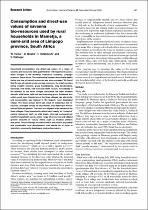 ResearchSpace
ResearchSpace
Consumption and direct-use values of savanna bio-resources used by rural households in Mametja, a semi-arid area of Limpopo province, South Africa
JavaScript is disabled for your browser. Some features of this site may not work without it.
- ResearchSpace
- →
- Research Publications/Outputs
- →
- Journal Articles
- →
- View Item
| dc.contributor.author |
Twine, W

|
en_US |
| dc.contributor.author |
Moshe, D

|
en_US |
| dc.contributor.author |
Netshiluvhi, T

|
en_US |
| dc.contributor.author |
Siphugu, V

|
en_US |
| dc.date.accessioned | 2007-03-14T07:23:50Z | en_US |
| dc.date.accessioned | 2007-06-07T10:03:24Z | |
| dc.date.available | 2007-03-14T07:23:50Z | en_US |
| dc.date.available | 2007-06-07T10:03:24Z | |
| dc.date.issued | 2003-09 | en_US |
| dc.identifier.citation | Twine, W, et al. 2003. Consumption and direct-use values of savanna bio-resources used by rural households in Mametja, a semi-arid area of Limpopo province, South Africa. South African Journal of Science, vol. 99, 10 September, pp 467-473 | en_US |
| dc.identifier.issn | 0038-2353 | en_US |
| dc.identifier.uri | http://hdl.handle.net/10204/1903 | en_US |
| dc.identifier.uri | http://hdl.handle.net/10204/1903 | |
| dc.description.abstract | Household consumption and direct-use values of a range of savanna bio-resources were quantified for 110 households across three villages in the Mametja Traditional Authority, Limpopo province, South Africa. The relationship between household wealth status and use of natural resources was also assessed. The researchers found that the use of natural resources was extensive, the most common being wooden utensils, grass handbrooms, twig handbrooms, fuel wood, wild herbs, wild fruit and edible insects. Households in the poorest of the three villages consumed the most wooden utensils, wild herbs, wild fruit and thatching grass. Fuel wood was widely used, even though two of the three villages had electricity, and consumption was highest in the largest, most developed village. The mean annual direct-use value of indigenous bio-resources, averaged across all households, was R3959 per household or R564 per person. The value was highest in the poorest of the three villages. Poor households relied most heavily on 'essential' natural resources such as wild foods, whereas comparatively wealthy households used a wider range of resources and utilized greater amounts of 'luxury' items, such as wooden utensils and poles. These findings are discussed in the context of poverty and sustainable rural development, and should be of value to scientists, community developers, and policy-makers | en_US |
| dc.format.extent | 233625 bytes | en_US |
| dc.format.mimetype | application/pdf | en_US |
| dc.language.iso | en | en_US |
| dc.publisher | Acad Science South Africa | en_US |
| dc.rights | Copyright: 2003 Acad Science South Africa | en_US |
| dc.subject | Savanna bio-resources | en_US |
| dc.subject | Mametja | en_US |
| dc.subject | Limpopo province | en_US |
| dc.subject | South Africa | en_US |
| dc.subject | Savanna consumptions | en_US |
| dc.title | Consumption and direct-use values of savanna bio-resources used by rural households in Mametja, a semi-arid area of Limpopo province, South Africa | en_US |
| dc.type | Article | en_US |
| dc.identifier.apacitation | Twine, W., Moshe, D., Netshiluvhi, T., & Siphugu, V. (2003). Consumption and direct-use values of savanna bio-resources used by rural households in Mametja, a semi-arid area of Limpopo province, South Africa. http://hdl.handle.net/10204/1903 | en_ZA |
| dc.identifier.chicagocitation | Twine, W, D Moshe, T Netshiluvhi, and V Siphugu "Consumption and direct-use values of savanna bio-resources used by rural households in Mametja, a semi-arid area of Limpopo province, South Africa." (2003) http://hdl.handle.net/10204/1903 | en_ZA |
| dc.identifier.vancouvercitation | Twine W, Moshe D, Netshiluvhi T, Siphugu V. Consumption and direct-use values of savanna bio-resources used by rural households in Mametja, a semi-arid area of Limpopo province, South Africa. 2003; http://hdl.handle.net/10204/1903. | en_ZA |
| dc.identifier.ris | TY - Article AU - Twine, W AU - Moshe, D AU - Netshiluvhi, T AU - Siphugu, V AB - Household consumption and direct-use values of a range of savanna bio-resources were quantified for 110 households across three villages in the Mametja Traditional Authority, Limpopo province, South Africa. The relationship between household wealth status and use of natural resources was also assessed. The researchers found that the use of natural resources was extensive, the most common being wooden utensils, grass handbrooms, twig handbrooms, fuel wood, wild herbs, wild fruit and edible insects. Households in the poorest of the three villages consumed the most wooden utensils, wild herbs, wild fruit and thatching grass. Fuel wood was widely used, even though two of the three villages had electricity, and consumption was highest in the largest, most developed village. The mean annual direct-use value of indigenous bio-resources, averaged across all households, was R3959 per household or R564 per person. The value was highest in the poorest of the three villages. Poor households relied most heavily on 'essential' natural resources such as wild foods, whereas comparatively wealthy households used a wider range of resources and utilized greater amounts of 'luxury' items, such as wooden utensils and poles. These findings are discussed in the context of poverty and sustainable rural development, and should be of value to scientists, community developers, and policy-makers DA - 2003-09 DB - ResearchSpace DP - CSIR KW - Savanna bio-resources KW - Mametja KW - Limpopo province KW - South Africa KW - Savanna consumptions LK - https://researchspace.csir.co.za PY - 2003 SM - 0038-2353 T1 - Consumption and direct-use values of savanna bio-resources used by rural households in Mametja, a semi-arid area of Limpopo province, South Africa TI - Consumption and direct-use values of savanna bio-resources used by rural households in Mametja, a semi-arid area of Limpopo province, South Africa UR - http://hdl.handle.net/10204/1903 ER - | en_ZA |





